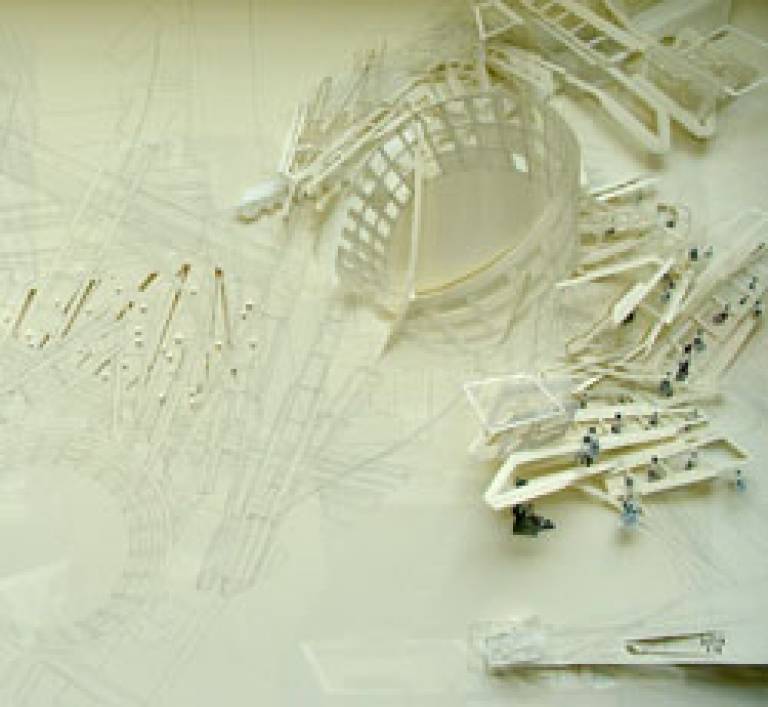Bartlett triumph at Royal Academy
15 June 2006
UCL Bartlett School of Architecture staff have won all three architecture prizes in the 2006 Royal Academy Summer Exhibition.
 C J Lim won both the Best Work Award and the Worshipful Company of Chartered Architects Award, and Patrick Weber received the Best First Time Exhibitor award.
C J Lim won both the Best Work Award and the Worshipful Company of Chartered Architects Award, and Patrick Weber received the Best First Time Exhibitor award. The UCL Bartlett pair managed to beat off stiff competition from some of the world's most celebrated architects - including Zaha Hadid and Norman Foster - to take the top honours.
Lim, who won the best newcomer award last year, received his prizes for a novel scheme to revamp Battersea Dog's Home. By day the new home is essentially a park for the dogs to exercise in and by night a series of portable recycled-card kennels are lowered down to house the animals. Surrounding the park are benches arranged as in a stadium. Their purpose is twofold: to enable potential new owners to view a prospective pet, and also seat spectators for dog racing competitions, held on a purpose-built track.
However, one of the most radical aspects of the scheme is the dog dating scheme, designed to bring prospective owners together with their ideal pet. Screens in the park would display adverts such as: "Attractive, excitable, No D/D, independent, American Jack Russell WLTM SBM, 3-4 years for LTR. Enjoys long romantic walks, car journeys" or "(Hit me) baby one more time! Bearded Collie, adventurous, slimmish responds well to dominant commands, leather collars and leads essential".
The models and drawings of the dog's home were painstakingly created by Lim by cutting out tiny images of dogs and figures from magazines, and then photocopying and hand-colouring them, before arranging them in display cases. The end result is a multi-layered collage, he explains: "It's important for researchers like myself to look into alternative ways to present ideas. The technique brings about a different way of thinking about buildings. It enhances the narrative of architecture. It layers the spatial experiences."
Weber's award-winning entry took the writings of Jorge Luis Borges, Sir Thomas More and German philosopher Johann Valentin Andreae as its inspiration. The project, 'A journey through utopia - a house', takes the form of a model from which a series of four cases unfold, each containing a room based on a different utopian ideal described by one of the writers.
Weber is interested in the dichotomy of representing utopias in three dimensions: "The task of the utopian is to conceive for his utopia an ideal designed to remain inaccessible, ie an ideal that can and must exist only in the mind. Utopias exist, according to the definition of the word utopia, only in our imagination. It can't have a physical location somewhere outside in the real world."
The solution he arrived at is displayed at the Royal Academy. Taking the premise that utopias can only ever exist in the mind, Weber constructed the models so that they were on a scale of 1000 to 1, or mind-sized. The result is a set of highly detailed models which measure no more than 40mm. Perhaps the most remarkable of these is 'The Garden of the Forking Paths', which has Weber's 5,000 word MA dissertation etched onto it.
'The Garden of the Forking Paths' forms the second room of the house and describes the precise moment in which you make a decision: "There are theories according to which an infinite number of parallel histories exist at the same time side by side. The reality we are living in is only one possibility out of these different storylines. Every decision creates a new bifurcation and fixes a new path into the future. A metaphor for this could be 'The Garden of the Forking Paths'. This garden consists of endless paths and so called 'binary' forkings splitting the path into two paths. You have to decide which path you take and each path leads to the next forking. Some decisions are important, some might be unimportant - you'll probably know it when the present is history. But anyway, as soon as you decided to go one way or another the forking behind you locks itself, blocking the other path, and, at the same time, makes it impossible to turn back."
Both Weber's and Lim's models will be on display at the Royal Academy Summer Exhibition until 20 August 2006. The exhibition is the world's largest open contemporary art exhibition and features paintings, sculptures, drawings, prints and architectural models. There were more than 8,000 submissions to this year's exhibition, which were then whittled down to the 900 pieces on display, 200 of which comprise the architecture section. To find out more about the exhibition, use the link at the top of this article.
Images:
1 and 2 CJ Lim
3 Patrick Weber
- Link:
- RA Summer Exhibition
 Close
Close

